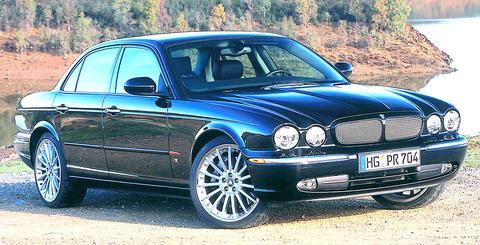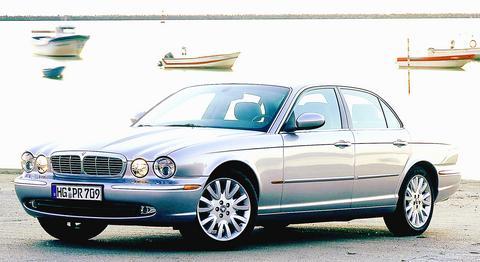If you are an import-car enthusiast of a certain age, you remember the jokes: if you want to drive a Jaguar, buy two -- one of them will always be in the shop.
After Ford bought Jaguar in 1989, it made reliability a top priority. Joe Ivers, executive director of quality and customer satisfaction for J.D. Power & Associates, a market research firm, noticed the change.

PHOTO: NY TIMESN
"Throughout the '90s Jaguar had what I would characterize as a very athletic, consistent and dramatic improvement in initial quality," Ivers said.

PHOTO: NY TIMES
And when the Power survey checked Jaguars as they aged, they became increasingly reliable with each consecutive year. The improvements have been noted by owners and those who make a rather busy living working on the cars.
"If all we did was try to service new Jaguars, like we did back in the '80s, it would be a pretty dicey proposition," said Earl Gibbs, owner of North Coast Exotics in Cleveland, who has been repairing Jaguars since 1968.
There are still enough vintage cars, however, to keep him busy.
When Ron Tencati, a government worker from northern Virginia, considered buying a used XJ6 Vanden Plas two years ago, he was concerned about the quality.
"I did some research and learned that after Ford bought them their reliability got much better, and I've had no trouble," said Tencati, one of several owners who responded to a query posted at Edmunds.com.
Willing to recommend
Many cars have a few problems, but Gibbs says he has no qualms recommending that a friend buy an XJ6 from the mid- to late 1990s.
"In the past, it would have been reckless to recommend that someone buy an 8-year-old Jaguar," he said.
Improvements in quality have also been noticed by Ed Harrison at Coventry West, an Atlanta company that sells Jaguar parts.
The observations are backed up by J.D. Power's Vehicle Dependability Index, a survey of 30,000 original owners of vehicles four to five years old.
"To us, it has been sort of surprising to see Jaguar in the real high ranks of VDI," Ivers said. "It's not the place where we have seen them in the past."
In the 2002 dependability study, which looked at 1998 models, Jaguar ranked ninth with 280 problems per 100 vehicles. Lexus was first with 159 problems.
Third place
Jaguar did even better the year before. In the 2001 study, Lexus was first with 173 problems per 100 vehicles, Infiniti was second with 219 and Jaguar was third with 250.
That doesn't mean Jaguar owners had a free ride. Some of the durability issues owners mentioned in surveys on the last-generation XJ8 centered on uneven tire wear, brake noise and problems with the engine-control computer. But these were not seen as serious problems, Ivers said.
"There still is a good distance to cover before it's in the Lexus range, but the underappreciated fact is that Jaguar long-term durability is in the same range as vehicles produced by Toyota," he said.
While life with a Jaguar cannot be expected to be trouble-free, some owners figure other factors compensate. Bill Alderman of Dallas has owned three Lexuses, but finds them sterile.
"They are all fantastic cars, but after about six months it becomes a car," he said. His '96 XJR continues to enchant him.
"To me it looks like it's going about 60 when it's sitting in the garage," he said.
Ups and downs
Some Jaguar owners, however, have turned their backs on the XJ and gone German; sometimes the reasons had nothing to do with quality.
"The first time I walked into the dealer I walked right past the new XJ, because I thought it was the X-Type, the small one," said Barry Fromberg, chief financial officer for Dean Foods in Dallas.
Ivers said that Jaguar tended to stumble in the quality rankings in the years when it brought out new vehicles. It tends to recover the next year.
In 1999, Jaguar ranked first out of 36 automakers in initial quality. In 2000, the year the S-Type was introduced, it dropped to 10th, Ivers said. Then in 2001 it rose to second. In 2002, when the X-Type was new, Jaguar dropped to 19th (out of 35). This year, it was 10th.
"That raises the question about the XJ," Ivers said. "Will they struggle with that launch?"

LONG FLIGHT: The jets would be flown by US pilots, with Taiwanese copilots in the two-seat F-16D variant to help familiarize them with the aircraft, the source said The US is expected to fly 10 Lockheed Martin F-16C/D Block 70/72 jets to Taiwan over the coming months to fulfill a long-awaited order of 66 aircraft, a defense official said yesterday. Word that the first batch of the jets would be delivered soon was welcome news to Taiwan, which has become concerned about delays in the delivery of US arms amid rising military tensions with China. Speaking on condition of anonymity, the official said the initial tranche of the nation’s F-16s are rolling off assembly lines in the US and would be flown under their own power to Taiwan by way

OBJECTS AT SEA: Satellites with synthetic-aperture radar could aid in the detection of small Chinese boats attempting to illegally enter Taiwan, the space agency head said Taiwan aims to send the nation’s first low Earth orbit (LEO) satellite into space in 2027, while the first Formosat-8 and Formosat-9 spacecraft are to be launched in October and 2028 respectively, the National Science and Technology Council said yesterday. The council laid out its space development plan in a report reviewed by members of the legislature’s Education and Culture Committee. Six LEO satellites would be produced in the initial phase, with the first one, the B5G-1A, scheduled to be launched in 2027, the council said in the report. Regarding the second satellite, the B5G-1B, the government plans to work with private contractors

MISSION: The Indo-Pacific region is ‘the priority theater,’ where the task of deterrence extends across the entire region, including Taiwan, the US Pacific Fleet commander said The US Navy’s “mission of deterrence” in the Indo-Pacific theater applies to Taiwan, Pacific Fleet Commander Admiral Stephen Koehler told the South China Sea Conference on Tuesday. The conference, organized by the Center for Strategic and International Studies (CSIS), is an international platform for senior officials and experts from countries with security interests in the region. “The Pacific Fleet’s mission is to deter aggression across the Western Pacific, together with our allies and partners, and to prevail in combat if necessary, Koehler said in the event’s keynote speech. “That mission of deterrence applies regionwide — including the South China Sea and Taiwan,” he

‘NARWHAL’: The indigenous submarine completed its harbor acceptance test recently and is now under heavy guard as it undergoes tests in open waters, a source said The Hai Kun (海鯤), the nation’s first indigenous defense submarine, yesterday began sea trials, sailing out of the Port of Kaohsiung, a military source said. Also known as the “Narwhal,” the vessel departed from CSBC Corp, Taiwan’s (台灣國際造船) shipyard at about 8am, where it had been docked. More than 10 technicians and military personnel were on deck, with several others standing atop the sail. After recently completing its harbor acceptance test, the vessel has started a series of sea-based trials, including tests of its propulsion and navigational systems, while partially surfaced, the source said. The Hai Kun underwent tests in the port from